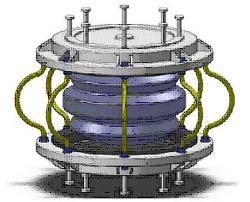Apr 23 2010
Research on the application of seismic isolation methods carried out by a team at the Universitat Politècnica de Catalunya (UPC)-Barcelona Tech will lead to better protection of buildings, infrastructure, and sensitive equipment subjected to dynamic loads caused by seismic activity. The overall aim of the research program is to mitigate the damage caused by earthquakes.
 The Roll-n-cage (RNC) is the device designed by the UPC-Barcelona Tech Control, Dynamics and Applications Group (CoDAlab).
The Roll-n-cage (RNC) is the device designed by the UPC-Barcelona Tech Control, Dynamics and Applications Group (CoDAlab).
The team has designed a system that reduces the negative effects of movements on a supported object. The system can be applied on a large scale to reduce motion induced in buildings and bridges by earthquakes and other vibration sources. On a small scale, it can be used to protect motion-sensitive equipment, including measuring devices, precision machines and instruments of the type found in laboratories, research centers and operating rooms, as well as museum pieces, antiquities, and other valuable objects stored in buildings.
The new application, for which a patent is being sought, is an advanced seismic isolator known as the roll-n-cage (RNC) isolator. The device was developed based on a doctoral thesis by Mohammed Ismail entitled "An innovative isolation device for aseismic design," within the framework of the Control, Dynamics and Applications Group (CoDAlab), under the direction of José Rodellar, in the Department of Applied Mathematics III of the School of Civil Engineering of Barcelona (ETSECCPB) and the College of Industrial Engineering of Barcelona (EUETIB).
The roll-n-cage (RNC)
The roll-n-cage (RNC) is an anti-vibration device that can play a significant role in protecting buildings and civil engineering works, as well as valuable objects and precision instruments that could be subjected to impacts or seismic movements.
The device is positioned between the object and the ground or any other support surface to produce horizontal decoupling between the two. Ideally, when the ground moves the supported object should remain motionless and maintain a complete vertical connection to prevent falls caused by gravity.
The RNC isolator, constructed using common materials such as steel and rubber, is based on simple principles and technologies that have been implemented in an innovative way to provide essential features not found in other isolation devices used in professional practice up to now. The majority of seismic isolators currently available still have practical limitations that prevent them from working as intended, restrict their effective use, and limit the level of protection provided. The RNC has the potential to outperform existing devices under light, moderate and severe conditions.
Reducing seismic demand rather than strengthening structures
The device, which incorporates isolation, energy dissipation, buffer and restoring force mechanisms in a single unit, is based on the concept of reducing or mitigating seismic demand rather than increasing the resistance capacity of structures. The RNC provides multi-directional isolation by dissipating energy and restraining uplift and maximum horizontal displacements. It improves vibration isolation, which up until now has been achieved by using different types of elastomeric bearings, including high-damping neoprene bearings and lead-plug rubber bearings, and by means of friction pendulum and other systems.
Numerical simulation to reach an aseismic design
Before moving on to the stage of constructing experimental prototypes, the design and validation process has been carried out using software and numerical simulation. First, the mechanical properties of the RNC isolator had to be characterized. This was accomplished by using a computer code that simulates the way devices respond when real testing equipment is used. This made it possible to perform a numerical analysis of the behavior of the RNC isolator under the simultaneous effect of horizontal and vertical loads, as typically occurs in real-life situations.
To evaluate the feasibility of the RNC isolator and verify its ability to protect structural and non-structural systems from seismic hazards, the device has been numerically implemented in a variety of light- and heavy-mass structures, and with sensitive equipment housed on the upper floors of such structures. In order to obtain information and draw relatively general conclusions about the performance of the RNC isolator, the researchers studied a broad range of earthquakes, the characteristics and properties of existing isolators, and a large number of localized structures of the most common types.
Numerical results obtained indicate that the roll-n-cage (RNC) can reduce the seismic response to a broad range of seismic movements, and that it exhibits robust performance for a wide variety of structures.
The team is currently receiving financial assistance from the Government of Catalonia's ACC1Ó program to construct experimental prototypes and confirm the RNC's potential as a practical, effective and economical seismic isolation device that overcomes the main drawbacks of existing systems while maintaining their principal advantages. The project is aimed at exploiting the new technology and bringing it to the market.
Source: http://www.upc.edu/